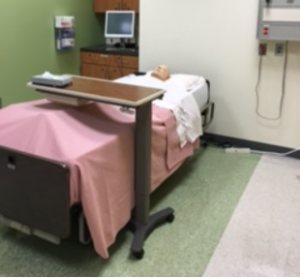12 High-Fidelity Simulations
Carrie Lewis Miller
Learning Objectives
- Distinguish between high-fidelity and digital simulations
- Describe opportunities to integrate simulations into educational contexts
Simulations are created situations that mimic real-life situations that learners are likely to encounter in the content area. Simulations are highly used in medical education, military training, and machinery training. Simulations can vary in their fidelity level or their similarity to real-life situations.
High-fidelity simulations are the most realistic and are used heavily to train nurses and doctors. They are also being used to train law enforcement officers. High-fidelity simulations, as shown in Figures 6-7, often require the use of actors or hidden participants that act as voices or controllers of mannequins.

Figure 6: High-fidelity law enforcement simulation with three officer trainees and an instructor “acting” as a disruptive bar patron.
High-fidelity simulations often require investments in equipment, technology, and personnel due to the realistic nature of the scenarios. The benefits to the investment in labs or simulation rooms include the increase in skill transfer to real-life scenarios and the opportunity for review and reflection as a post-action report. Often, simulations are recorded and participants have the opportunity to review their performance with their instructors to receive feedback and clarification.

Figure 7: High-fidelity nursing simulation with an electronic mannequin. The mannequin includes a speaker that can be voiced by an instructor or actor from a control booth.
Studies have shown mixed results on the efficacy of high-fidelity versus low-fidelity simulations (Munshi et al., 2015). However, evidence points to the efficiency of simulations in general for increasing learning gains. The essential elements in any simulation include opportunities for feedback, repetition of skills, and relevance to the curriculum. Researchers in the area of high-fidelity simulations suggest that the largest benefit to the use of high-fidelity simulations is in increasing learner self-efficacy and allowing them to demonstrate to themselves that they can perform the skills they are learning (Dunn et al., 2014).
References
Dunn, K. E., Osborne, C., & Link, H. J. (2014). Research briefs high-fidelity simulation and nursing student self-efficacy: Does training help the little engines know they can? Nursing Education Perspectives, 35(6), 403-404.
Munshi, F., Lababidi, H., & Alyousef, S. (2015). Low-versus high-fidelity simulations in teaching and assessing clinical skills. Journal of Taibah University Medical Sciences, 10(1), 12-15.
Recommended Supplementary Material
- Gredler, M. E. (2004). Games and simulations and their relationships to learning. Handbook of research on educational communications and technology, 2, 571-581. http://www.aect.org/edtech/ed1/21.pdf
- Roberts, D., & Greene, L. (2011). The theatre of high-fidelity simulation education. Nurse Education Today, 31(7), 694-698. doi:10.1016/j.nedt.2010.06.003

